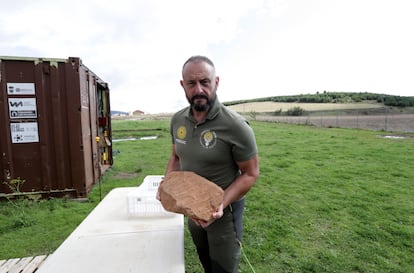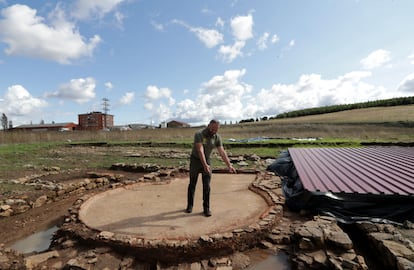A metal fence guards an apparent wasteland on the outskirts of Aguilar de Campoo (Palencia, 6,900 inhabitants). Inside, two construction containers. In the background, water rafts and tarps. Jesús Torres wanders through there, Kechu, the archaeologist thanks to whom a Roman establishment from the 1st century has emerged on that plot, times of expansion of the Empire throughout the Peninsula. It is the Huerta Varona site, where remains of a swimming pool, a probable sauna, a massage space and “oyster bags” are concentrated. The findings and materials point to that early phase of Emperor Trajan’s command, with an unprecedented set in Spain and with little international parallel. All despite the few resources that the excavator has had, with poor public support and small private contributions, in addition to avoiding the threat of looters.
The recent storms have swamped part of the space, also showing the skill of the builders in preparing canals and drains, still useful 2,000 years later. Torres multiplies himself with a pump hose to extract water, and shows the protections destroyed by the wind, which cover especially delicate areas of this Hispano-Roman settlement and a mosaic covered by sand. “Welcome to little Venice,” he greets. “It is a very hot archaeological area and it was discovered due to looting in the eighties,” explains the specialist. Hence the name: they were orchards where very ancient vestiges appeared. Torres suspects that many surrounding residents possess pieces of this legacy and that certain jumps in living standards may be due to the sale or trafficking of coins, ornaments or pieces of special value. The Palencia archaeologist shows remains of glass, the head of a nail and blocks of construction materials such as bricks, tiles, canal protections, parts of columns and even a block with strange little circles on the clay. “They are caliga (shoe) studs from the toe of a boot,” says the researcher, whose conclusions and knowledge allow him to reconstruct the development of this foundation and its type of life. The the work of signs, brick or tile concrete mixed with lime, constituted “paths” between the apartments.
“Probably, it was a town and not just a town due to the extension that the georadar has marked,” he highlights, since some voices pointed to a mere town of a wealthy Roman. There was a good standard of living, he assures at the foot of a pool, carefully excavated by technician Javier Atienza, “not for swimming, but for bathing”: the surface that surrounds it – circular and without corners so as not to accumulate scab – proves that there People gathered to talk and cleanse themselves. Next to it, the oven hole where wood was burned and, through the still visible ducts, the air heated the water. Another construction is considered a shroud, a room to sweat and eliminate toxins. Next, another space for hair removal and eliminating “nits, lice and parasites.” In the garbage dump, “sacks of oysters” brought from the Cantabrian Sea in barrels of seawater, quite a challenge then. The archaeologist adds that finds such as an unguentary, transferred to the Museum of Palencia for its value, prove that Romans from what is now England lived there, since similar elements are kept in the British Museum: “It could also be a place of retreat for military leaders. “who were thus thanked for their service, perhaps in the wars against the Cantabrians.”
The archaeologist points out that similar places have barely been found in Rome and Pompeii (Italy), with some relatively similar sites in Tarragona or Zaragoza, but without this state of conservation. He took over the management several years ago and is dealing with the scarcity of resources and the disinterest of the Administrations. The economic circumstances, with a budget of barely 30,000 euros per year between the Aguilar de Campoo City Council (PSOE) and the Provincial Council (PP), mean that Torres can only intervene for a few months, in summer, with other archaeologists whom he hires and some volunteers or young students. The rest of the year, covered. They know little about the Junta de Castilla y León (PP) beyond the excavation permit. The pool, discovered two years ago, suffered from the action of vandals or thieves: “There are neighbors who keep a little watch, but there are people who enter with night vision glasses.” Added to this are the rains, snows and frosts, which crack or damage the vestiges once they are brought to light. The team of archaeologists intervenes for about four summer weeks at the site, 12 hours a day, and for another four weeks analyzes what was found. They could go faster, the person in charge admits, but the means are scarce and he prefers to go with caution.

Jesús Torres dreams of a “stable laboratory.” By the way, when you have resources, a video surveillance circuit against criminals. He would also like help for researchers in the form of support for residence during periods of work, because with Huerta Varona “the Virgin has appeared to Aguilar de Campoo,” he says, a discovery that anticipates the constitution of this population by about 1,000 years. campurriana “You have to invest in excavating and protecting, the ruins are not just tourism, they must have social profitability,” he says. “Every year I hold an open house so residents can learn what this is and what their taxes are for; On the last occasion they came 172″. Winter is lurking and the days are short, a sign of the end of the season. Now, to spread tarps, pray that the rain does not flood the site and that the plunderers do not wage war on the Roman legacy.

